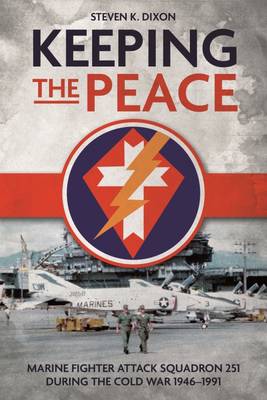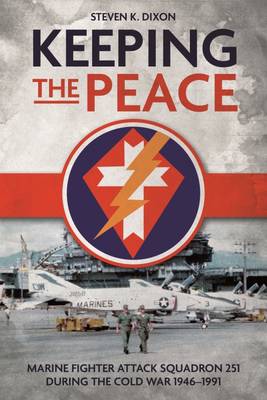
- Retrait gratuit dans votre magasin Club
- 7.000.000 titres dans notre catalogue
- Payer en toute sécurité
- Toujours un magasin près de chez vous
- Retrait gratuit dans votre magasin Club
- 7.000.0000 titres dans notre catalogue
- Payer en toute sécurité
- Toujours un magasin près de chez vous
Keeping the Peace
Marine Fighter Attack Squadron 251 During the Cold War 1946-1991
Steven K Dixon
Livre relié | Anglais
48,95 €
+ 97 points
Description
The complete operational history of an outstanding Marine fighter squadron throughout the Cold War.
The Thunderbolts of VMFA-251 were reactivated as a Marine Air Reserve squadron in 1946. Their Cold War only included a few weeks of traditional combat operations--in Korea--but they would undertake constant training exercises and deployments from 1946 to 1991 as they prepared for a potential war against the USSR or China, the two giants of Communism. From South Korea to Norway to Turkey and points in between, the Thunderbolts found themselves defending the free world and living up to their motto, Custos Caelorum.
Following the end of the Korean War, the squadron remained in the Far East until 1956. Back in the States it began flying the FJ-3 Fury, a jet fighter, before converting to its first supersonic fighter, the F-8U "Crusader." In early 1962, it was the first Marine F-8 squadron to deploy aboard an aircraft carrier, as part of CVW-10 (Carrier Air Wing) aboard the USS Shangri-La. During deployment in the Mediterranean Sea, the squadron set a record for the most flight time in one month for a Sixth Fleet-based F-8 squadron by flying over 500 hours. In 1964, the Thunderbolts were the first Marine squadron in 2nd Marine Aircraft Wing to transition to the F-4B "Phantom II," which they would fly for 21 years and 80,000 flight hours, until transitioning to the F/A-18 "Hornet" in 1987.
These deployments and exercises, while not "at war," were not without dangers. The Thunderbolts lost many personnel and aircraft, but they persevered as the armed forces of freedom-loving nations faced the ongoing threat of communism for over four decades. Compiled from archive records and interviews by a veteran of VMFA-251, this account narrates how the Thunderbolts worked hard to maintain the peace. They were indeed Custodians of the Sky.
The Thunderbolts of VMFA-251 were reactivated as a Marine Air Reserve squadron in 1946. Their Cold War only included a few weeks of traditional combat operations--in Korea--but they would undertake constant training exercises and deployments from 1946 to 1991 as they prepared for a potential war against the USSR or China, the two giants of Communism. From South Korea to Norway to Turkey and points in between, the Thunderbolts found themselves defending the free world and living up to their motto, Custos Caelorum.
Following the end of the Korean War, the squadron remained in the Far East until 1956. Back in the States it began flying the FJ-3 Fury, a jet fighter, before converting to its first supersonic fighter, the F-8U "Crusader." In early 1962, it was the first Marine F-8 squadron to deploy aboard an aircraft carrier, as part of CVW-10 (Carrier Air Wing) aboard the USS Shangri-La. During deployment in the Mediterranean Sea, the squadron set a record for the most flight time in one month for a Sixth Fleet-based F-8 squadron by flying over 500 hours. In 1964, the Thunderbolts were the first Marine squadron in 2nd Marine Aircraft Wing to transition to the F-4B "Phantom II," which they would fly for 21 years and 80,000 flight hours, until transitioning to the F/A-18 "Hornet" in 1987.
These deployments and exercises, while not "at war," were not without dangers. The Thunderbolts lost many personnel and aircraft, but they persevered as the armed forces of freedom-loving nations faced the ongoing threat of communism for over four decades. Compiled from archive records and interviews by a veteran of VMFA-251, this account narrates how the Thunderbolts worked hard to maintain the peace. They were indeed Custodians of the Sky.
Spécifications
Parties prenantes
- Auteur(s) :
- Editeur:
Contenu
- Nombre de pages :
- 288
- Langue:
- Anglais
Caractéristiques
- EAN:
- 9781636241937
- Date de parution :
- 08-02-23
- Format:
- Livre relié
- Format numérique:
- Genaaid
- Dimensions :
- 152 mm x 229 mm
- Poids :
- 576 g

Les avis
Nous publions uniquement les avis qui respectent les conditions requises. Consultez nos conditions pour les avis.






